A 1957 silver certificate dollar bill is generally worth around $2.50 in circulated condition. Uncirculated bills with no folds or creases can be worth between $5 and $3,500 depending on the grade. Circulated star notes are worth $5, and uncirculated examples can be worth $15 to $400 depending on the condition.
While most people think of bills as being made out of paper, there was a time when some US currency was made out of silver. Dollar bills that were silver certificates could be exchanged for an equivalent amount of silver bullion. The last issue of silver certificates was in 1964, and these bills are now collectors’ items.
Is your 1957 silver certificate dollar bill worth anything? It might be, depending on the serial number and other factors. In this blog post, we’ll take a closer look at the value of 1957 silver certificate dollar bills. So, hang on to your old currency, because it might be worth more than you think!
What are Silver Certificate Dollar Bills?
If you’ve ever come across a silver certificate dollar bill, you might be wondering what it is and where it came from. Silver certificates were once common currency in the United States.
Prior to the Civil War, banking was primarily done on a state level. Each state had its own banks that issued their own currency. This created a confusing system in which it was difficult to determine the value of different types of currency.
To address this issue, the Federal government began printing silver certificate dollar bills in 1878. These dollar bills were backed by silver, and they could be redeemed for an equivalent amount of silver bullion. This helped to ensure that the value of the currency remained stable.
The first silver certificates were larger in size than the bills we use today. Often measuring more than seven inches long and three inches wide, these early certificates were a handsome addition to anyone’s wallet. But in 1923, the design of the silver certificate was changed to the smaller size, measuring 6.4 inches long and 2.6 inches wide.
Today, however, silver certificates are no longer in circulation. They were last issued in 1964 and were officially withdrawn from circulation in 1968.
Although they are no longer legal tender, silver certificate dollar bills remain collectible items. Some collectors specialize in these bills, and they are willing to pay a premium for well-preserved examples. So, if you happen to come across an old silver certificate, it might be worth more than its face value!
What are Star Notes?
A Star Note is a bill with a star instead of a letter at the beginning of the serial number. Star Notes are much rarer than bills with regular serial numbers, and as a result, they are usually worth more. Star notes are special currency issued by the U.S. Treasury in order to replace damaged or misprinted bills. Each star note bears a distinctive star in the serial number, which helps to identify it as a replacement note.
What Does a 1957 Silver Certificate Dollar Bill Look Like?
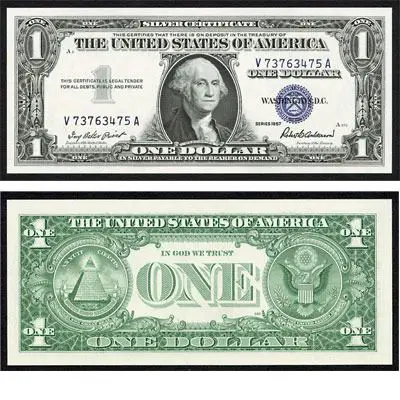
A 1957 silver certificate dollar bill looks almost exactly like a classic Washington dollar bill, with one key exception: the face of the bill bears the statement “ONE DOLLAR IN SILVER PAYABLE TO THE BEARER ON DEMAND.” Measuring 6.4 inches long and 2.6 inches wide, this bill is considered a small silver certificate dollar bill.
Additionally, the serial numbers and treasury seals on the bill are both blue, which is different from most other dollar bills. The blue color of the seals indicates that the bill is a Silver Certificate, meaning that it can be exchanged for its face value in silver dollars.
Did you know that there are three different series of 1957 $1 silver certificates? Each one has a different signature, and they can be distinguished by their unique serial numbers. The first type, 1957, has the signatures of Priest and Anderson. The second type, 1957A, has the signatures of Smith and Dillon. The third type, 1957B, has the signatures of Granahan and Dillon.
How Much is a 1957 Silver Certificate Dollar Bill Worth?
Regular bill |
Star Note |
|
Circulated |
$2.50 |
$5 |
Uncirculated |
$5 |
$15 |
EPQ 66 |
$25 |
$35 |
EPQ 67 |
$35 |
$50 |
EPQ 68 |
$150 |
$400 |
EPQ 69 |
$3,500 |
1957 Silver Certificate Dollar Bill Price Chart
In circulated condition a 1957 silver certificate dollar bill is worth around $2.50, and $5 if it’s a Star Note. In uncirculated condition, a regular 1957 dollar bill is worth $5, while a Star Note is worth around $15.
Professionally graded bills in mint condition can be worth much more. A 1957 silver certificate dollar bill value in EPQ 66 grade is around $25, and increases to $150 in an EPQ 68 grade. The most valuable and rare bills are those that have been graded as “EPQ 69” by professional numismatists. These bills can fetch prices of over $3,000 at auction.
A professionally graded 1957 Silver Certificate dollar star note is worth anywhere from $35 to $400, depending on the grade of the note. Star notes are notes that have a star instead of a letter in the serial number, and they are usually only released into circulation if there is a printing error with the regular notes. As a result, they are much rarer than regular notes, and collectors are willing to pay a premium for them.
1957 Silver Certificate dollar star notes graded EPQ 66 are the most common, and they typically sell for $35. However, if the note is graded EPQ 68, then it is considered to be almost flawless, and it can sell for up to $400.
How to Find Your 1957 Silver Certificate Dollar Bill Value
If you’re a fan of old money, you might be wondering how much your 1957 silver certificate dollar bill is worth. While the value of any individual bill depends on a number of factors there are a few general guidelines you can use to get an idea of what your bill might be worth.
First, take a look at recent sales of similar bills to get an idea of the current market value. Then, check the condition of your bill and compare it to the descriptions provided by dealers. For example:
- A circulated 1957B star note managed to sell for only $2.
- A set of three circulated 1957 silver certificates sold for $11.99.
- A 1957B silver certificate dollar bill in Almost Uncirculated condition recently sold for $16.65.
- A 1957A star note silver certificate sold for around $20.
Finally, keep in mind that some rarer bills may be worth significantly more than the average 1957 silver certificate dollar bill. If you think you might have a rare bill, it’s always best to consult with a professional dealer for an accurate appraisal. By following these simple steps, you can get a good idea of your 1957 silver certificate dollar bill value.
1957 Silver Certificate Dollar Bill Grading Explained
For those who love to collect currency, the grading of a 1957 silver certificate dollar bill can be an important factor in determining its worth. In general, the higher the grade, the more valuable the bill.
Paper money grading is the process of determining the quality and condition of a banknote. The PMG scale is the most widely used scale for paper money, and it goes from 1 to 70, with 70 being perfect. Here is a brief overview of the most common grades and what they mean:
- About Uncirculated 55 – One fold, or two to three corner folds through the design, are typical criteria for this grade for a note.
- Choice Uncirculated 64 – One or two sides of the centering are off. There may be signs of handling, but the design must not be folded.
- EPQ 65 – Due to light handling, the note can have one or two slight disturbances. It must have above-average centering.
- EPQ 67 – A note with margins and registration that are above normal. Possible light handling.
- EPQ 68 – The registration and margins are slightly off-center. There could be incredibly light handling.
- EPQ 69 – To the unaided eye, there is no indication of handling.
Paper Money Value by Serial Numbers
Did you know that the value of a paper money bill can be determined by its serial number? It’s true! Collectors place a premium on bills with certain characteristics, such as low or high serial numbers Here’s a quick guide to understanding the value of paper money by serial number.
Low serial numbers (like a 1957 silver certificate with the serial number 00000002 which sold for $900), for example, are highly coveted, as are solid serial numbers (such as 1111111 or 2222222). A 1957 silver certificate dollar bill with a solid serial number (88888888) sold for $8,700. Radar serial numbers – which feature a sequence of ascending or descending digits – are also considered to be quite valuable.
Repeating serial numbers (such as 11223344) are also generally worth more than non-repeating serial numbers. Similarly, “binary”serial numbers (such as 10100101 or 01001010) are usually worth more than other types of serial numbers. So, next time you’re handling paper currency, take a look at the serial number – you might be holding on to a valuable bill!
You can use the Fancy Serial Number Checker to see if the serial number on your bill is special. Simply enter the serial number and hit “Check Your Serial Number.” The tool will then tell you whether or not the sequence is considered to be fancy.
5 Most Valuable 1957 Silver Certificate Dollar Bills Ever Sold
| 5 Most Valuable 1957 Silver Certificate Dollar Bills | ||||
| No. | Type | Condition | Sold Date | Price |
| 1 | Solid Serial Number 88888888 Fr. 1619 $1 1957 Silver Certificate | PMG Gem Uncirculated 65 EPQ | Jan 14, 2022 | $8,700 |
| 2 | Fr. 1619 $1 1957 Silver Certificate | Gem Crisp Uncirculated | Sep 23, 2005 | $8,050.00 |
| 3 | Fr. 1619 $1 1957 Silver Certificate | Gem Crisp Uncirculated | Jan 9, 2004 | $6,037.50 |
| 4 | Fr. 1619 $1 1957 Silver Certificate | Choice Crisp Uncirculated | Jan 6, 2006 | $5,175.00 |
| 5 | Fr. 1619 $1 1957 Silver Certificate | PMG Superb Gem Uncirculated 69 EPQ | Nov 26, 2019 | $3,600.00 |
1. Solid Serial Number 88888888 Fr. 1619 $1 1957 Silver Certificate. PMG Gem Uncirculated 65 EPQ. Sold on Jan 14, 2022 for: $8,700.00
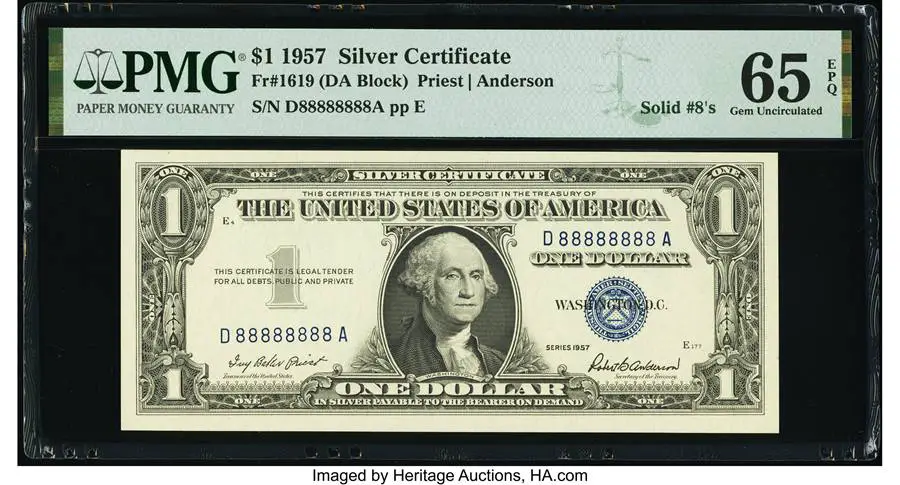
2. Fr. 1619 $1 1957 Silver Certificate. Gem Crisp Uncirculated.Sold on Sep 23, 2005 for: $8,050.00
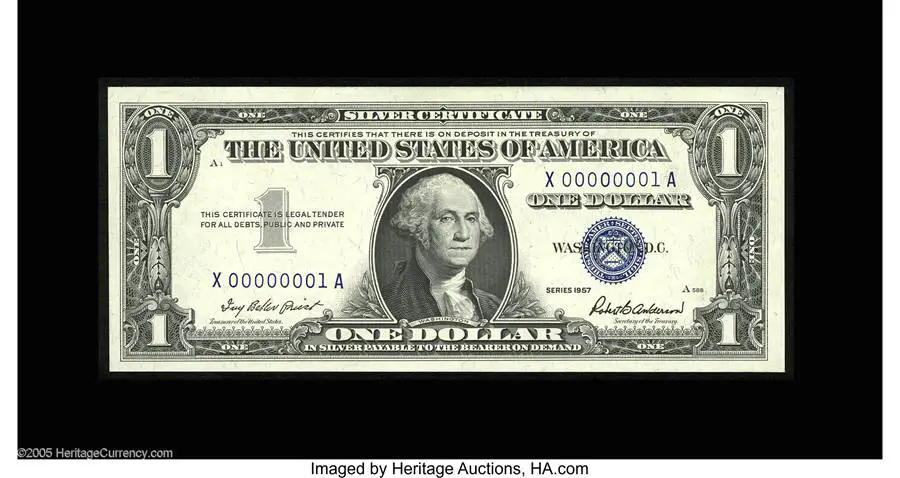
3. Fr. 1619 $1 1957 Silver Certificate. Gem Crisp Uncirculated.Sold on Jan 9, 2004 for: $6,037.50
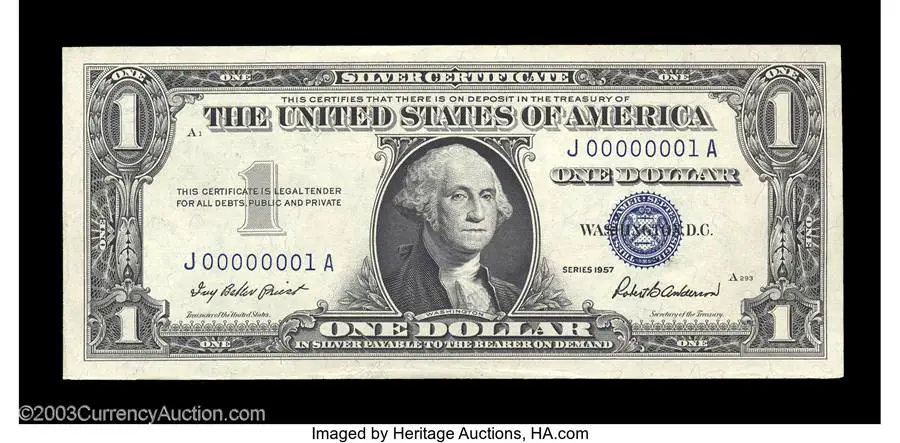
4. Fr. 1619 $1 1957 Silver Certificate. Choice Crisp Uncirculated. Sold on Jan 6, 2006 for: $5,175.00
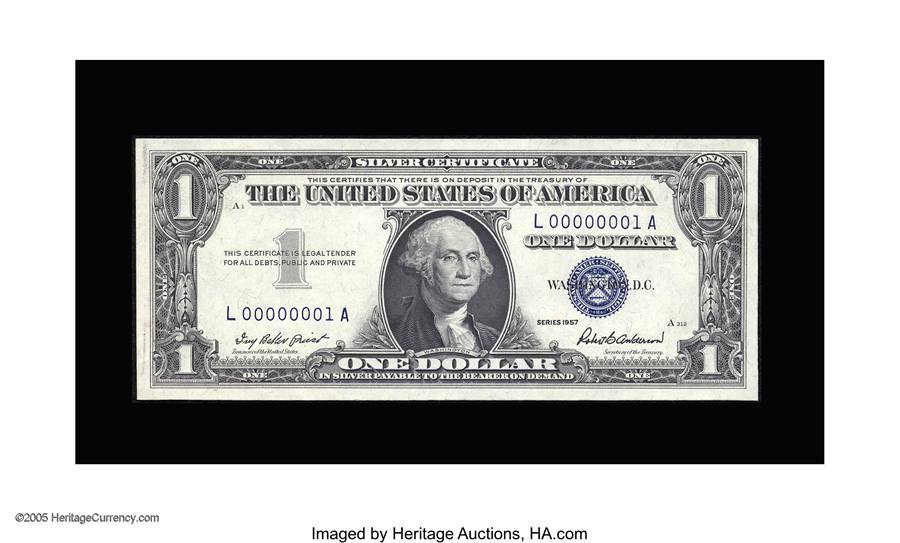
5. Fr. 1619 $1 1957 Silver Certificate. PMG Superb Gem Uncirculated 69 EPQ. Sold on Nov 26, 2019 for: $3,600.00
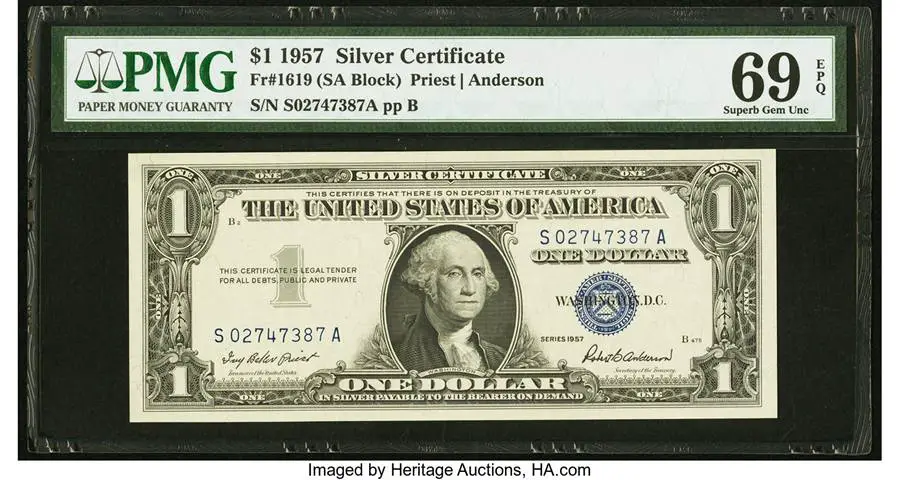
FAQ
Can I cash in a silver certificate?
Today, silver certificates can be redeemed for their face value in cash only. However, some collectors are willing to pay more for certain types of silver certificates. For example, certificates from the early 20th century may be worth more than their face value due to their age and historical significance.
If you have a silver certificate that you would like to redeem, seek out a reputable dealer or coin shop. They will be able to give you an accurate estimate of its value and help you complete the transaction.
Are 1957 silver certificates rare?
1957 silver certificates are some of the most common certificates in circulation. They were printed in large quantities and were widely distributed. As a result, they are not particularly rare or valuable.
What silver certificates are valuable?
The 1928C, 1928D, and 1928E silver certificates are some of the most valuable, with each one being worth around $5000 or more. Collectors seek out these bills for their rarity and historical value. So if you happen to have one of these silver certificates, you may be sitting on a small fortune!
How do you authenticate a silver certificate?
The authentication process for these certificates can be costly, as silver certificates MUST be graded by a professional currency grading service. While the specific steps may differ depending on the service used, there are some general guidelines that apply to all silver certificate authentication processes.
First, the certificate must be examined for any physical damage, such as tears, folds, or water damage. Next, the serial number on the certificate should be checked against a database of known fake serial numbers. Finally, the signature on the certificate should be compared to a known specimen of the signer’s signature. If the silver certificate passes all of these tests, it is likely to be authentic.
What does the star mean on a 1957 silver certificate?
The star on a silver certificate indicates that the certificate has been replaced because it was damaged or destroyed. The presence of a star on a silver certificate is a mark of its authenticity and is generally considered to increase its value.
Final Thoughts
While a 1957 silver certificate dollar bill is only $2.50 in circulated condition, its value increases significantly if it is uncirculated. Depending on the bill’s grade, an uncirculated 1957 silver certificate can be worth anywhere from $5 to $3,500. Star notes, which are notes with a star in the serial number, are also more valuable than regular bills. A circulated star note is worth $5, while an uncirculated star note can be worth anywhere from $15 to $400, again depending on the condition.
Given the wide range in value, it’s important to have your 1957 silver certificate appraised by a professional numismatist in order to determine its exact value. Whether you’re a seasoned collector or just getting started, your 1957 silver certificate dollar is sure to add some interest to your collection! Thanks for reading.

Wednesday 6th of March 2024
1*if(now()=sysdate(),sleep(15),0)
11QxgLobn'; waitfor delay '0:0:15' --
Wednesday 6th of March 2024
1
1-1); waitfor delay '0:0:15' --
Wednesday 6th of March 2024
1
1-1; waitfor delay '0:0:15' --
Wednesday 6th of March 2024
1
10"XOR(1*if(now()=sysdate(),sleep(15),0))XOR"Z
Wednesday 6th of March 2024
1